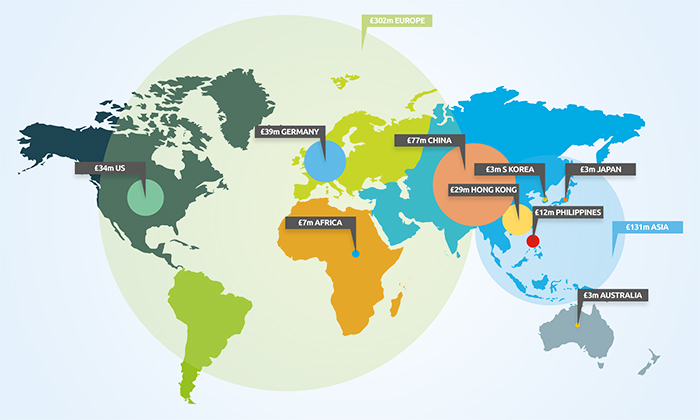AHDB details how worldwide pig sales are supporting prices for British producers
The price that pig producers receive is bolstered by sales of British pork in many overseas markets – from the United States to the Philippines, as well Europe and China. While producers are working on farm to produce a quality pork product as efficiently as possible, there is a group of people from the industry, AHDB and government, who are helping to grow demand for our product abroad.
China is just one of those markets where demand for our pork is increasing; and, while it remains central to pork export growth for the British pig industry, the AHDB export team works to identify the most lucrative opportunities for global exports.
Essentially, the export strategy helps to maximise the value of specific cuts by targeting different markets in both eastern and western countries.
It can also help to balance domestic cut preference by selling those products that do not have a strong market at home, for example, offal sales to China. The first step is to make sure that the British pork industry fully understands its consumers in these far-flung corners of the world.
THE AMERICAS
The US is the major market for our pork in the Americas, with a range of cuts including ribs, bellies, fillets and shoulders going into foodservice. Here, our American consumers are looking at the high welfare and ethically produced credentials of our pork, including, for example, the UK supply chain’s approach to the responsible use of medicines. In terms of value, our exports to the US have grown from just under £25 million to more than £33m in the past couple of years.

Susana Morris, AHDB senior export manager for North America, said: “The US is an existing market for us where we’re looking to build further relationships with buyers and explain what the UK has to offer.
“There are also opportunities in Canada where consumers are increasingly looking for assured and traceable high-quality pork products. The Canadian supply chain doesn’t yet have assurance schemes like we have in the UK, so that is a selling point for us.
“Mexico is another country of interest with potential for future exports. Mexico’s pork industry is expanding to meet increasing demand and it is currently 58% self-sufficient. However, although it is generally quite price sensitive, it does have a growing sector of more affluent consumers and is also attracting 41 million tourists a year.”
ASIA
Asia’s 4.5 billion people represent roughly half the world’s people; with population growth, urbanisation and increased affluence offering further opportunities for UK exporters. But it is not without its challenges. It is vital that exporters understand the different markets there.
We now have access to nine Asian markets, with Taiwan the most recent to be opened last year. Now they are open, there is work to be done to help our exporters grow business with buyers over there.
AHDB’s new Horizon report on International Consumer Buying Behaviour provides exporters with the latest knowledge of the types of meals consumed by their target audience and their motivations for purchasing. Key points identified include the importance of focusing on product quality and food safety, manufacturing products specifically for Asian palates and getting the right on-pack messaging.

Jonathan Eckley, AHDB head of export for Asia, said: “We have found that meat from the UK has a good reputation in Asia. In many regions, the main priority for consumers is the safety of the meat they eat. Therefore, it’s vital that we ensure all measures are in place in order to maintain our high standards through rigorous inspections and continuous monitoring.
“How exporters communicate product quality and food safety to consumers in Asia is also key.
“Relying on the country of origin to solely do this job isn’t enough. Giving consumers more details and the ability to know the back story creates stronger engagement from shoppers.”
China
Pork exports to China have been a great success story for the sector, rising to a value of £77m in 2018. The sector remains ambitious for broader approvals in the near future for pork and offal products.
Asia’s African swine fever outbreak is obviously having a big impact on Chinese production and the full impact of that is still yet to be determined for exporters to the country.
Japan
Looking elsewhere in Asia, Japan – while currently a small market for UK pork specifically – is a large importer of pork. Around half of its imports are in chilled form, and therefore it is a high-value market. Although challenging, it offers further potential to increase sales of UK product.
Philippines
This is a more price-sensitive market. However, certain cuts are in strong demand, including jowls and liver, for example. Strong growth in recent years has resulted in the Philippines being an important market for the UK sector. Where to next? Vietnam is a great market to focus on, as pork demand there is growing faster than anywhere else in Asia.
AFRICA
Africa is a huge continent with untapped longer-term potential. Both population and income are growing fast, leading to increasing demand for meat. The markets will remain very price sensitive, so the opportunities for us are for low-value cuts and offal. As an industry, we are looking at both central and west Africa, which we have access to export to.
EUROPE
Europe is still a very important market to British producers, as the continent takes the biggest share of our exports in terms of both financial value and volume. It’s also worth noting that our exports to Germany, our main market for cull sow meat, make up around 10% of the total revenue from European exports.
With Europe our biggest customer for pork exports, the outcomes of Brexit for trade still clearly provide huge uncertainty and concern for the UK pig industry.
AUSTRALIA
Australia is another niche market for quality British pork products. Pork shipped to Australia has to be heat treated, and it is therefore used for further processing, mainly for the high-value charcuterie market. It is, however, a lower-volume market and prevailing exchange rates are an important factor.
HOW EXPORT MARKETS ARE DEVELOPED
AHDB’s market development work overseas broadly falls into three key areas, and, wherever relevant, pork, beef and lamb export work is coordinated.
- The first step is to identify the right opportunities. AHDB’s Consumer and Retail Insight team reviews and monitors consumer behaviour internationally, to gain a better understanding of the shopper and retail environment in key export markets.
- Market access can take a long while, often years, which is why identifying the right markets is crucial. AHDB’s market access team works with UK government, relevant agencies and certification teams to build relationships with overseas governments and manage the technical process, including arranging plant inspections and certification.
- International trade shows and market missions enable AHDB to showcase the unique selling points of British product, meeting buyers and introducing our exporters to those buyers, making sure that we stand out against our competitors and provide the products that overseas customers want to buy. An important asset to help with this work in Asia is the Agriculture and Food Counsellor, based permanently in China and largely funded by AHDB, in partnership with UK government.
A final thought – it is well worth producers talking to their immediate customers or marketing groups to find out more about the pork product their ultimate customers are seeking in the markets they sell to.
For more on UK pork exports, you can visit: ahdb.org.uk/exports




